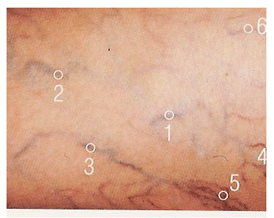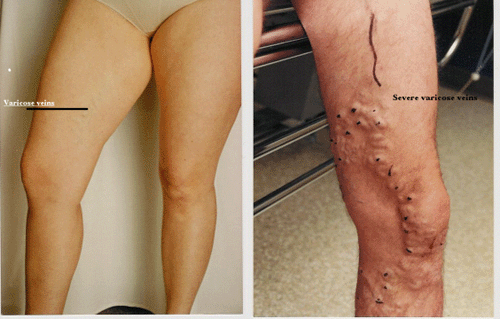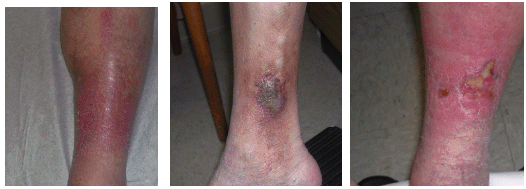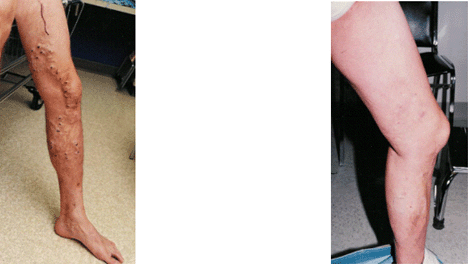What Are Varicose Veins?
The term “varicose veins” is used in a very broad way to describe a range of abnormalities affecting the venous system.
Defining Vein Abnormalities:
Varicose veins are chronic, dilated (enlarged) easily felt and located in the fatty tissues under the skin. They are greater than 4mm in diameter. There are other forms of visible vein abnormalities.
Reticular veins are dilated, located at the deep surface of the skin and are less than 4mm in diameter and generally cannot be felt.
Telangiectasias are dilated vessels within the skin and are less than 1mm in diameter. They cannot be felt. They may occur in clusters and are often referred to as “spider veins”.

Various forms of abnormal veins.
The development of varicose veins may occur with or without evidence of the other forms of pathology. Spider veins in the legs are far more prevalent in females due to their relationship to estrogen levels and the effect of the hormone on vascular smooth muscle.
Telangiectasias and reticular veins are widely acknowledged to be cosmetic problems and are not generally associated with any major forms of pathology or disability. The treatment, if pursued is, through the use of a sclerosant solution. Laser therapy has failed to improve on the results of sclerotherapy and while it may seem attractive and high tech, it is expensive but not superior in the analysis of outcomes. Treatment of telangiectasias and reticular veins is not a service offered by our practice. Cosmetic services of this type are often found through one’s local family physician or through a skin clinic offering a full range of cosmetic services. Practitioners of sclerotherapy often advertise this service in the physician’s section of the Yellow Pages.
Note:
If varicose veins coexist with the above lesions, they should be dealt with first and the cosmetic procedure deferred until the more severe pathology is adequately controlled.
How do true Varicose Veins develop?
The most common cause of varicose veins is the failure of the valves at certain critical junctions to prevent reflux of blood from the deep veins of the leg through the superficial veins under the skin. The most common site of this failure is the “sapheno-femoral junction” located in the groin. As the valve fails, pressure in the superficial veins rise as they are subjected to a high volume of blood flowing in the reverse direction, down the leg. The pressure is equal to the weight of the column of blood form the heart to the lowest point of valve incompetence. As the problem progresses, it eventually works its way down to the ankle where the maximum pressures are exerted. The most serious consequences of varicose veins and valve dysfunction tend to occur around the ankle due to the fact that the pressures are the highest at this point.
The pattern of varicose veins may vary from one individual to another and can be influenced by the point(s) of origin of the reflux or valve failure. In simple cases, the groin may be the only source of reflux and therefore can be dealt with by a fairly standardized surgical procedure. In more complex cases multiple areas may be involved and may require imaging studies to determine the sources of reflux.
Varicose veins may develop in relationship to obstruction to flow in the deep veins of the leg or pelvis. In this situation imaging studies are very important and surgery to remove the varicose veins is less likely to be advisable.
Classifying Venous Diseases
The classification of venous disease is important. It allows accurate analysis of large volumes of cases and the response to treatment. The following is the clinical classification agreed upon by the Joint Council of the Society of Vascular Surgery:
| Class 0 | No visible or palpable signs of venous disease |
| Class 1 | Telangiectasias, reticular veins, malleolar flare |
| Class 2 | Varicose veins |
| Class 3 | Edema without skin changes |
| Class 4 | Pigmentation, eczema, lipodermatosclerosis |
| Class 5 | Skin changes as above plus healed ulceration |
| Class 6 | Skin changes as above with active ulceration |
Why do Varicose Veins develop?
It is true that many women experience first onset of varicose veins during pregnancy but it is also clear that the problem does not have an overwhelming preponderance for women. Approximately 10% of the adult population has varicose veins and the ratio of female to male is approximately 60% to 40%. Sedentary activity (prolonged standing in on spot, sitting) causes pooling of blood in the legs and increases the pressure on the valves. Obesity obviously creates higher pressures. These are all factors that may contribute to and aggravate varicose veins.
There is a definite tendency for the problem to run in families. While a specific genetic factor has not yet been identified, it would make sense to recognize the fact and consider preventative measures and early intervention when a problem does seem to be developing.
What are the treatment options?
Most of the severe problems that eventually develop in patients with longstanding varicose veins are the result of neglect. Since the problem is directly tied to increased pressures within the superficial veins of the leg it stands to reason that controlling these forces can improve the long term course of the problem.
Lifestyle Changes
Walking or any related activity that makes use of the pumping action of the calf/leg muscles to accelerate blood return out of the leg to the heart is beneficial. It follows that weight reduction can also help with symptoms and slow the progression of the problem. It may also make any intervention more safe and successful.
Support (Compression) Stockings
Symptomatic relief of the pain, heaviness and aching associated with varicose veins can be achieved with the use of good quality support stockings. The use of these stockings will not eliminate the problem but can certainly slow the progression of it and prevent many of the more advanced features of chronic venous disease from developing.
The degree of support is measured in units of pressure (millimetres of mercury-mmHg). The reference point is the ankle since this is where the greatest internal pressures are generated. The stockings are designed to create a graduated form of support so the pressure declines as one moves up the leg. There is no doubt that the stockings become more valuable with more advanced and complex degrees of venous disease. It also stands to reason that any person with elements of varicose vein disorder would be well served if they committed to wearing support.
Since most of the severe problems occur in the lower third of the leg, the greatest benefit is obtained by wearing a knee length stocking. As the pressure increases to match the severity of the disorder, it can become more awkward wearing a stocking that extends above the knee. Since they can slip and need readjustment or feel very hot and restrictive many people soon tire of wearing them. It is my own bias that the greatest benefit is derived from the below knee support so I seldom prescribe therapeutic stockings above the knee.
Recomended strength by severity
- Mild, uncomplicated varicose veins or for patients who have had successful treatment, an over the counter (non-prescription) stocking can be obtained. These are available in a variety of colours and may be a below-knee or pantyhose configuration. The cost may be $20.00 to $25.00 per pair. These may generate 10-15 mmHg pressure.
- Symptomatic varicose veins should have a therapeutic strength (20-30 mmHg). These require a prescription. They are approximately $100.00 per pair. Extended health benefits will cover these but Pharmacare will not. They will last about six months with regular washing and wear. They are available with cotton liners or nylon liner to accommodate different skin types.
- Complicated Varicose veins (those with skin changes and history of ulcer formation) need a stronger stocking ( 40-50 mmHg) and should be evaluated for any coexistent arterial disease due the tightness of the stocking.
The stockings should be fitted early in the day so that the leg is not swollen. There are numerous good products available but the two superior lines are Sigvaris and Jobst.
Sclerotherapy
The injection of a caustic substance into the vein is carried out in the office of the practitioner. The solution is toxic to the lining of the vein. The resulting inflammation creates a scar that hopefully seals the vein so blood can no longer flow through it rendering it invisible. This approach has many proponents. It is clearly the best treatment for Telangiectasias and Reticular veins. It is a temporary solution at best for more advanced varicose veins if there is uncorrected reflux. There is an attraction to it since it is clearly not surgery. In order to get good results with true varicose veins it must be done aggressively and requires frequent follow up. Results do vary however. If blood accumulates in the injected vein it can clot leaving a ropy scar with permanent discoloration. The main vein may be replaced by smaller telangiectasias. If the solution is injected outside the vein an ulcer may develop in the skin. This may take several weeks to heal and leave a permanent scar. When used for true varicose veins the site is often compressed either with a tensor bandage or a compression stocking. Walking is encouraged. For more complex cases it may be wise to have the procedure done when one can have a few days off work so that prolonged standing or sitting do not compromise results.
Note:
If you decide to pursue a course of sclerotherapy as the main form of treatment rather than surgery, ask your family physician to refer to a practitioner with this area of interest. Due to time constraints and other priorities this is not a service that can be offered through my office at this time.
Surgery
The aim of surgery is twofold:
- control reflux
- remove varicosities
The first objective requires a clear understanding of the sources of reflux and accurate planning. If successful there is usually a significant improvement in symptoms from this aspect alone. The second is the “cosmetic aspect of the operation. Removing the actual varicose veins does enhance the symptomatic improvement but also removes the majority of the unsightly veins that represent much of the motivation to seek treatment. The most common form of this operation involves an incision in the groin where the long Saphenous vein is identified, and divided. There are at least five tributaries in this area, like a busy traffic intersection, that must be tied off. Once this is accomplished the vein is exposed at the level of the knee. A stripping device is passed to the groin and the vein is removed between these two incisions. The varicosities (marked carefully preoperatively) are then removed using a small scalpel blade and a series of tiny instruments much like twirling spaghetti on a fork. The leg will look bruised for a week or so but full unrestricted activity is expected by two weeks in the vast majority of cases. Variations on this technique are applied to specific areas if other zones of reflux are identified. If appropriate both legs may be done at the same surgery. This may affect the rate of recovery and limit activity in the postoperative period more severely.
Some scarring is unavoidable with the surgery but is minimized. The amount of scarring is far less obvious than the veins themselves. View the post operative instructions.
Which treatment is best for me?
This presentation is not a substitute for a surgical consultation. It may however allow one to be more informed about the choices to be made. Lifestyle modifications and the use of support stockings are applicable to everyone. These suggestions are the starting point. If a more aggressive solution is sought the following points should be kept in mind.
- Telangiectasias and reticular veins are cosmetic lesions. The treatment if sought is not covered by MSP. Sclerotherapy is the most common and appropriate form of therapy. New lesions may develop in other sites over time. Risk of significant complications (skin ulcer) are about one percent.
- Varicose veins are best treated with surgery in uncomplicated cases. The results are proven, the recurrence rate with appropriate surgery is estimated at 20%. The investment of adequate recovery time is important and may be problematic for some but it is well worth the effort. Sclerotherapy without surgical control of reflux has virtually a 100% recurrence rate. For lesser degrees of varicose veins where symptoms are minimal it may be appropriate to pursue sclerotherapy as a form of treatment but recognize that it is a temporary solution.
- Patients with Significant skin changes (C4,5,6) should be seen and evaluated so that an appropriate plan can be devised for long term control of the problem. By the time these changes set in some degree of irreversible damage has already developed.
Guide to treatment Options
The following is a guide to allow you to determine in advance what is the most appropriate choice to make. If surgery is being considered there are also options for expedited care in a private clinic or the usual hospital based procedure with a wait of 6-12 months.

Numbers 1-3 show reticular veins while 4-6 show telangiectasias. These area best dealt with by sclerotherapy.

The figure on the left shows a mild case and on the right a more severe case of uncomplicated varicose veins. Both are appropriate for day care surgical treatment.

Above Above left shows skin changes associated with advanced vein disease (C4). The middle picture shows the skin changes with healed ulceration (C5) and the picture on the right shows an active ulcer (C6).
Individuals with any of the above findings are in need of a thorough assessment and may need a combination of therapies. The role of surgery may be far more complex than a varicose vein procedure alone.
Results
With a thorough operation the recurrence rate is approximately 20% in the affected leg. With any of the other options recurrence rates are much higher. Recovery to the point of resuming full unrestricted activity is approximately two weeks (see post op varicose veins Hyperlink). Below is a before and after of a sever case of uncomplicated varicose veins.
